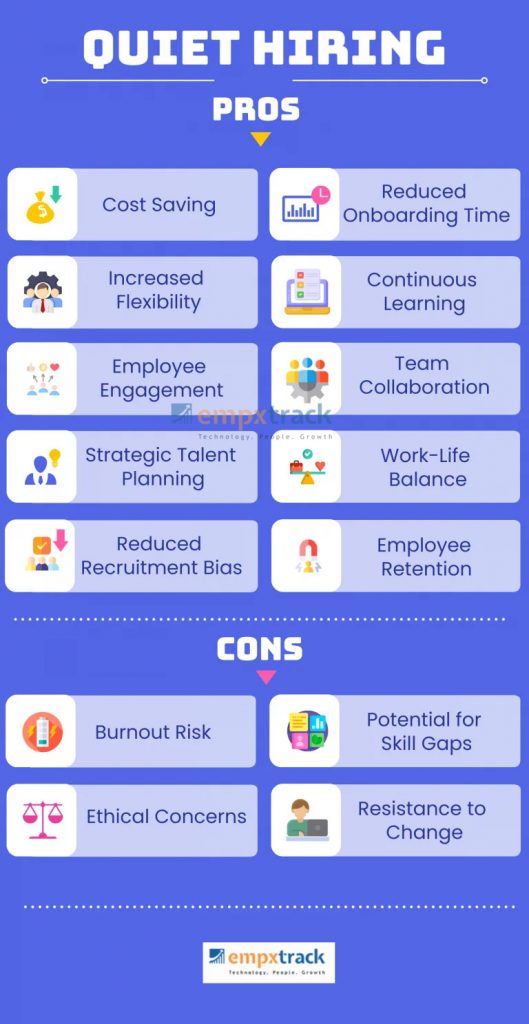The future of recruitment might be quieter than you think. Let’s explore what quiet hiring in the workplace means, its benefits for both companies and employees. Understand how this trend will shape the future of work and how you can seamlessly implement it in your organization.
After the recent HR trends like “quiet quitting” and “quiet firing”, a new phrase is gaining traction in workplaces: quiet hiring.
The trend is quietly reshaping how companies attract and develop talent, and it might just hold the key to a happier, more engaged workforce.
What is Quiet Hiring?
Imagine your boss approaching you with a new project, saying, “We have this new project, but we can’t hire anyone for it. Would you be interested in taking on some extra responsibility to help make it a success?“
Quiet hiring, in a nutshell, is about companies finding smart ways to get things done from their existing workforce, instead of automatically reaching for the “hire someone new”.
Also known as silent hiring or silent recruitment, this concept isn’t entirely new. Companies have been practicing it for a while, but it is gaining attention, especially in the post-COVID job market where layoffs picked up speed around late 2022.
There are two ways to do quiet hiring—internal and external. In internal quiet hiring, existing employees take on additional tasks and responsibilities, maximizing the potential of the current team without bringing in new hires. This way, the company maximizes its own talent pool to handle increased workloads.
In external quiet hiring, the company quietly searches for new talent outside the organization without making public announcements. This approach allows the company to bring in fresh perspectives and skills without the traditional hiring practices.
Why Is the Quiet Hiring Trend in the Workplace Gaining Popularity in Today’s Job Market?
Finding new talent is like putting together a puzzle for companies, especially when cost saving is a crucial factor. The idea of hiring an entirely new team may seem risky, yet filling skill gaps is crucial. To solve this puzzle, many companies are trying out quiet hiring in 2024.
Instead of spending a lot on bringing in new hires, they are quietly maximizing productivity with the talented individuals they already have. It’s like a secret plan to fill in the gaps without spending too much money.
80% of workers have experienced quiet hiring, with many seeing it as a skill development opportunity
This discreet hiring strategy is gaining popularity as a smart move for companies navigating tough times while maintaining the strength of their teams.
Benefits of Quiet Hiring in the Workplace
Silent hiring might be stealing the spotlight in the workplace, but its benefits aren’t limited to just one side. Let’s explore how the advantages of quiet hiring contribute to positive changes in the workplace, fostering a happy and smooth-sailing environment for everyone involved.
Benefits for Employers
Efficiency and Cost Savings
Employers benefit from a cost-effective and efficient solution to fill skill gaps without hiring additional full-time workers. This allows organizations to use internal talent, saving time and resources compared to lengthy recruitment processes.
In the fast-paced world of business, where time is money, the method emerges as a strategic shortcut, allowing companies to rapidly address their immediate needs while enhancing overall efficiency and keeping costs in check.
Upskilling for Retention and Productivity
Investing in upskilling employees not only fills skill gaps but also enhances employee engagement, retention, and productivity.
Companies like Google use quiet hiring in the workplace to identify and reward internal staff who go beyond their job descriptions. This approach leads to increased job satisfaction and loyalty. The tech giant actively promotes continuous learning by identifying individuals who consistently go above and beyond their roles. They invest in programs to teach employees new skills that match what the industry needs.
Talent Pool Expansion
Silent recruiting allows employers to tap into their internal talent pool, identifying individuals who may possess skills beyond their current roles. This expands the organization’s talent pool without the need for external recruitment.
Streamlined Hiring
Employers can quickly find and utilize their own people through silent hiring, bypassing the waiting time associated with hiring externally. This speedy approach ensures that companies can promptly address their needs without facing the challenges and delays often associated with lengthy external recruitment processes.
Benefits for Employees
Faster Onboarding
Employees involved in the process experience faster onboarding when taking on new responsibilities or roles. Since they are already familiar with the company culture and processes, the transition is smoother, thereby reducing the stress associated with a traditional onboarding process.

Reduced Time to Goal Achievement
As a result of the smoother transition facilitated by this approach, the time required by employees to make progress toward achieving goals is significantly reduced.
Using an automated HR solution makes the fast onboarding process even better, helping people settle into their new roles smoothly and efficiently.
Job Satisfaction
Employees engaged in discreet hiring strategies often experience increased job satisfaction. Recognition for their contributions and the opportunity to take on new challenges contribute positively to their overall work experience.
Career Growth
Silent hiring provides employees with chances for career growth within their existing workplace.
As they take on new responsibilities through this approach, employees get the chance to actively shape their careers. This, in turn, leads to long-term success and satisfaction in their professional journeys, aligning seamlessly with future work trends.
Work-Life Balance
When employees experience reduced stress and feelings of overwhelm at work, it naturally becomes easier for them to effectively manage their job duties. This ease of pressure enables individuals to strike a healthier balance between their work responsibilities and personal lives.
The approach can contribute to a better work-life balance by reducing external pressures and leveraging existing talent. It enhances job satisfaction, maintains team interactions, and promotes a balanced workload. Instead of putting extra pressure on the workforce through external hiring, companies can use their existing talent. This means they can balance their work responsibilities with their personal lives in a healthier way.
Overcoming Challenges in Quiet Hiring
While silent hiring offers numerous advantages, it also comes with its own set of challenges. It is important to address and overcome these challenges to ensure effective adoption of this approach. Here’s a closer look at some key hurdles to consider.
Internal Bias and Limited Opportunities
There’s a risk of choosing people we already know, making it harder for new faces to get a fair chance. To fix this, use clear rules to judge everyone and make sure all employees have equal chances to grow while you are doing silent hiring in the workplace.
Balancing Workloads
When existing employees take on new tasks without increased compensation or recognition, it can lead to burnout. Stop this by offering fair compensation, acknowledging contributions, and providing career growth opportunities aligned with new responsibilities.
Addressing Skill Gaps
Relying only on internal talent may not meet all your needs. Develop a proactive approach to identify external talent pools for specialized skills not readily available within your organization. Consider partnerships, professional networks, and targeted outreach to niche communities.
By prioritizing fairness, transparency, and employee development, you can navigate the quiet hiring challenges and maximize the benefits of this evolving talent acquisition strategy.
How to Implement Quiet Hiring in Your Company?
The implementation of quiet hiring in the workplace becomes a key element to activate your team, save money, and create an engaged workforce. Let’s explore 3 steps in the essential aspects of implementing it in your company.
Identifying Quiet Talent
To implement silent recruiting internally, companies need to identify individuals within their current workforce who possess skills that align with the needs of the organization. This involves a careful assessment of employees’ abilities, experiences, and potential for growth.
Regularly evaluating your team members allows you to stay informed about their evolving skills and interests. Maintaining open communication channels helps in understanding their career aspirations and areas where they would like to contribute more.
Encouraging Upskilling Initiatives
Establish an environment that values continual learning and development. Encourage employees to take on additional training and upskilling opportunities to enhance their skill sets. This not only benefits the employees personally but also equips them with the tools needed to contribute more effectively to the organization.
Companies can offer workshops, online courses, or mentorship programs to support employees in acquiring new skills. Recognize and reward those who actively engage in upskilling efforts, creating a positive cycle of learning and development.
Acknowledging Employee Contributions
Recognizing and appreciating employees who willingly take on additional responsibilities is crucial in implementing silent hiring effectively. Encouraging your team’s active participation, this simple yet powerful step boosts morale and motivation in the process. You can also consider the following:
- » Regular Recognition: Set up an HR system to frequently express gratitude to employees who go beyond their usual tasks.
- » Inclusive Appreciation: Ensure everyone in the company gets recognized, making everyone feel like they belong and achieve things.
- » Reward System: Give small rewards or bonuses to show appreciation for employees who help make silent hiring successful. Some employees may also appreciate additional PTO as a way to recognize their efforts.
Additional Tips:
- Leverage internal job boards and talent databases to advertise internal opportunities.
- Utilize employee referral programs to encourage existing staff to recommend qualified candidates.
- Promote employee well-being initiatives to ensure a supportive and healthy work environment.

How Tech Makes Quiet Hiring Easy
In the changing world of hiring, technology is important, especially for successful hiring. Instead of relying on traditional job posts and interviews, recruitment software now acts as a personal talent matchmaker. This innovative approach not only utilizes advanced technology in the hiring process but also emphasizes the need for a more detailed and personalized recruitment strategy to find and hire the best people.
Skills-Based Matching: Explore platforms that go beyond typical keyword searches, employing skills-based matching algorithms to identify internal talent with hidden potential. To refine your search and ensure you uncover all relevant talent, consider using residential proxies for more accurate, unrestricted geo-specific access to job market insights.
Automation for Efficiency: Automate tasks such as onboarding, sharing training materials, and tracking progress with platforms like Empxtrack. This frees up time for managers to focus on coaching and developing their teams. It’s a win-win for everyone involved.
Candidate Matching Platforms: These platforms analyze employee data and connect individuals to the right projects or positions within your company. This not only simplifies but also supercharges the quiet hiring process, ensuring it is both efficient and effective.
Empxtrack is a game-changer in the future workplace trend, making hiring and onboarding employees faster and more efficient. Smartly designed to manage resumes, short-list candidates, schedule interviews, generate offers, and seamlessly onboard candidates, Empxtrack is the solution organizations choose to reduce time-to-hire and save additional costs in the recruitment process.
This comprehensive approach not only addresses the challenges of current hiring practices but also positions organizations. The seamless integration of Empxtrack makes the entire hiring process easy and successful for quiet hiring in 2024.
The Final Thoughts
Exploring the potential of quiet hiring in the workplace offers a promising shift in the future of recruitment. It could make the process quieter, more strategic, and better aligned with the ever-changing work environment.
It isn’t just about saving money (who doesn’t love a bonus?). It’s about establishing a team for the future. The next superstar might be sitting right next to you, ready to showcase their talents. By using technology, changing how you hire, and thinking ahead, you can build a team that not only fits today’s needs but is also ready for whatever challenges come in the future.
Liked what you read? Let’s take it to the next level!
Frequently Asked Questions
Q1. | What is quiet hiring? |
| Ans. | Quiet hiring, also known as silent hiring or silent recruiting, is when companies find ways to fill skill gaps and address workload needs within their existing workforce. Instead of automatically opting for external hires, companies explore internal resources. They may also discreetly search for external talent without public announcements. This can involve assigning employees to new tasks or projects, providing upskilling opportunities, or offering internal job postings. |
Q2. | What is the quiet hiring trend in the workplace? |
| Ans. | Silent hiring is gaining popularity in 2024, as a way for companies to address their needs more efficiently and cost-effectively. Companies are using their existing workforce better instead of quickly hiring new people. This quiet hiring trend is picking up, especially after COVID, and has two main types: internal quiet hiring, where current employees take on more tasks, and external quiet hiring, where companies quietly look for talent outside. |
Q3. | How can quiet hiring be used for your business? |
| Ans. | Quiet hiring can benefit your business in various ways: Fill skill gaps: Recognize employees with skills that can be used in new areas, addressing specific skill shortages. Increase productivity: Provide current employees with opportunities to take on new responsibilities, contributing more to the overall productivity of the business. Boost employee morale: Show employees that you value their potential and are committed to their professional development, creating a positive work environment. Cost saving: Cut down on costs associated with traditional recruitment and onboarding processes, allowing for more efficient resource allocation. Talent pool expansion: Internal hiring allows you to tap into your existing talent pool, identifying individuals with skills beyond their current roles, and providing a broader range of expertise within the organization. |
Q4. | Is quiet hiring legal? |
| Ans. | Yes, this approach is generally allowed by the law, as long as the companies strictly follow employment rules. It means making smart choices within the current team or quietly looking for new talent from outside without violating legal hiring practices. |
Q5. | What are the disadvantages of quiet hiring? |
| Ans. | Some potential silent recruiting disadvantages in the workplace include: Employee burnout: Make sure employees are not overloaded with too much work. Lack of diversity: Focus on building a diverse talent pool within your existing team. Limited career progression: Ensure there are clear paths for employees to move forward in their careers. |
Q6. | Is quiet hiring right for your company? |
| Ans. | It is beneficial for companies that want to use their current team, save money, and make hiring simpler. It’s particularly beneficial when seeking efficient solutions to address immediate needs. Deciding if silent hiring is right for your company depends on your needs and culture. Think about things like your budget, how many people work for you, and the kind of business you have. |
Q7. | How does quiet hiring differ from traditional recruitment practices? |
| Ans. | Traditional recruitment practices typically involve posting job openings externally, attracting new candidates, and going through a formal interview process. On the other hand, quiet hiring in the workplace focuses on utilizing and developing existing talent. It is a more internal and strategic approach to recruitment. |




A timely and practical read about ‘quiet hiring’ – the trend of strategically upskilling and reassigning existing employees instead of always hiring new. The article explains it clearly and highlights how this approach can boost agility, retain talent, and fill skill gaps from within. A really smart perspective on modern workforce strategy!
Great insight! Quiet hiring offers a fresh perspective on talent acquisition.